Research News
- Classification of brain tumours using fine tuned ensemble of ViTs November 11, 2022
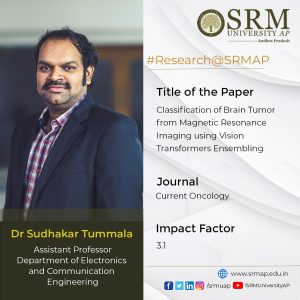
Primary brain tumours make up less than 2% of cancers and statistically occur in around 250,000 people a year globally. Medical resonance imaging (MRI) plays a pivotal role in the diagnosis of brain tumours and advanced imaging techniques can precisely detect brain tumours. On this note, Dr Sudhakar Tummala, Assistant Professor, Department of Electronics and Computer Engineering, has published a paper titled, “Classification of Brain Tumour from Magnetic Resonance Imaging using Vision Transformers Ensembling” in the journal Current Oncology having an impact factor of 3.1. The paper highlights the pioneering breakthrough made in the development of vision transformers (ViT) in enhancing MRI for efficient classification of brain tumours, thus reducing the burden on radiologists.
Abstract of the paper
The automated classification of brain tumours plays an important role in supporting radiologists in decision making. Recently, vision transformer (ViT)-based deep neural network architectures have gained attention in the computer vision research domain owing to the tremendous success of transformer models in natural language processing. Hence, in this study, the ability of an ensemble of standard ViT models for the diagnosis of brain tumours from T1-weighted (T1w) magnetic resonance imaging (MRI) is investigated. Pretrained and fine tuned ViT models (B/16, B/32, L/16, and L/32) on ImageNet were adopted for the classification task. A brain tumour dataset from figshare, consisting of 3064 T1w contrast-enhanced (CE) MRI slices with meningiomas, gliomas, and pituitary tumours, was used for the cross-validation and testing of the ensemble ViT model’s ability to perform a three-class classification task. The best individual model was L/32, with an overall test accuracy of 98.2% at 384 × 384 resolution. The ensemble of all four ViT models demonstrated an overall testing accuracy of 98.7% at the same resolution, outperforming individual model’s ability at both resolutions and their ensemble at 224 × 224 resolution. In conclusion, an ensemble of ViT models could be deployed for the computer-aided diagnosis of brain tumours based on T1w CE MRI, leading to radiologist relief.
A brief summary of the research in layperson’s terms
Brain tumours (BTs) are characterised by the abnormal growth of neural and glial cells. BTs causes several medical conditions, including the loss of sensation, hearing and vision problems, headaches, nausea, and seizures. There exist several types of brain tumours, and the most prevalent cases include meningiomas (originate from the membrane surrounding the brain), which are non-cancerous; gliomas (start from glial cells and the spinal cord); and glioblastomas (grow from the brain), which are cancerous. Sometimes, cancer can spread from other parts of the body, which is called brain metastasis. A pituitary tumour is another type of brain tumour that develops in the pituitary gland in the brain, and this gland primarily regulates other glands in the body. Magnetic resonance imaging (MRI) is a versatile imaging method that enables one to noninvasively visualise inside the body, and is in extensive use in the field of neuroimaging.
There exist several structural MRI protocols to visualise inside the brain, but the prime modalities include T1-weighted (T1w), T2-weighted, and T1w contrast-enhanced (CE) MRI. BTs appear with altered pixel intensity contrasts in structural MRI images compared with neighbouring normal tissues, enabling clinical radiologists to diagnose them. Several previous studies have attempted to automatically classify brain tumours using MRI images, starting with traditional machine learning classifiers, such as support vector machines (SVMs), k-nearest-neighbour (kNN), and Random Forest, from hand-crafted features of MRI slices. With the rise of convolutional neural network (CNN) deep learning model architectures since 2012, in addition to emerging advanced computational resources, such as GPUs and TPUs, during the past decade, several methods have been proposed for the classification of brain tumours based on the finetuning of the existing state-of-the-art CNN models, such as AlexNet, VGG16, ResNets, Inception, DenseNets, and Xception, which had already been found to be successful for various computer vision tasks.
Despite the tremendous success of CNNs, they generally have inductive biases, i.e., the translation equivariance of the local receptive field. Due to these inductive biases, CNN models have issues when learning long-range information; moreover, data augmentation is generally required for CNNs to improve their performance due to their dependency on local pixel variations during learning.Therefore, in this work, the ability of pretrained and fine tuned ViT models, both individually and in an ensemble manner, is evaluated for the classification of meningiomas, gliomas, and pituitary tumours from T1w CE MRI at both 224 × 224 and 384 × 384 image resolutions.
Dr Sudhakar Tummala has mentioned the social implications of the research by expounding that the computer-aided diagnosis of brain tumours from T1w CE MRI using an ensemble of fine tuned ViT models can be an alternative to manual diagnoses, thereby reducing the burden on clinical radiologists. He also explains the future prospects of his research, which is to add explainability to the ensemble model predictions and to develop methods for precise contouring of tumour boundaries.
Details of Collaborations
Prof Seifedine Kadry, Department of Applied Data Science, Noroff University College, Kristiansand, Norway.
Dr Syed Ahmad Chan Bukhari, Division of Computer Science, Mathematics and Science, Collins College of Professional Studies, St. John’s University, New York, USA.
Continue reading → - The security strength of an improved optical cryptosystem October 28, 2022
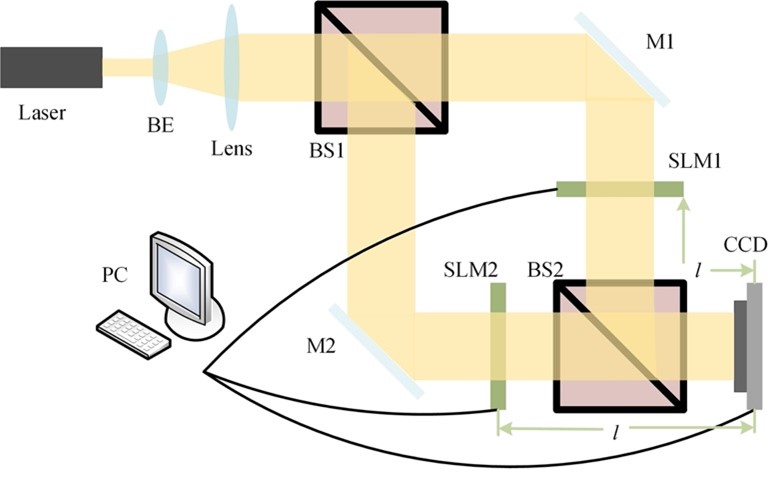 In the last few years, due to the enormous development in communication technology, the sharing, and transmission of information have increased immensely. The information can be transferred in various forms, such as text, audio, video, and images. Mostly, the information or data is transmitted through open channels, which increases the possibility of illegal interception, fabrication, and modification of the original information. Thus, to avoid unauthorised access or alteration of data, the development of secure transmission systems is very important.
In the last few years, due to the enormous development in communication technology, the sharing, and transmission of information have increased immensely. The information can be transferred in various forms, such as text, audio, video, and images. Mostly, the information or data is transmitted through open channels, which increases the possibility of illegal interception, fabrication, and modification of the original information. Thus, to avoid unauthorised access or alteration of data, the development of secure transmission systems is very important.The latest research from the Department of Physics evaluates the security strength of an improved optical cryptosystem based on interference. Assistant Prof Dr Ravi Kumar has published a paper, Security analysis on an interference-based optical image encryption scheme, in the Applied Optics journal, with an impact factor of 1.905.
Dr Ravi Kumar’s research is focused on the area of optical information processing and optical metrology. He studies and designs new optical cryptosystems with enhanced security features. For that, he uses various optical aspects and techniques, such as interference, diffractive imaging, polarization, computational imaging, etc. Alongside this, he also works in the area of digital holography and incoherent imaging. In this, he designs and develops new optical systems for imaging applications, such as super-resolution imaging, biomedical imaging, 3D imaging, telescopic applications, object detection, reconstruction, etc.
Explanation of the Research
Optical systems have been studied extensively for image encryption and found to be more reliable and efficient than their digital counterparts, such as parallel processing, capable of processing 2D data, multi-parameters capabilities (i.e., phase, wavelength, polarization, etc.), and can be employed as the security keys. The usage of biometric authentication in daily life, credit cards, fingerprint authentication, email/bank passwords, etc.; all need to be secured. This research can play an important role in designing a sophisticated cryptosystem for future technologies. Moreover, another direction of the research i.e., optical imaging, can be translated to design new low-cost biomedical devices (endoscopes, microscopes, biomedical sensors, etc.) which can have a significant social impact.
In the future, Dr Ravi Kumar will be focusing on the development of a new robust optical cryptosystem and designing new attack algorithms for existing optical encryption techniques. Additionally, he is also designing new optical imaging systems with better signal-to-noise ratios and improved resolution.
Abstract
In this paper, the security strength of an improved optical cryptosystem based on interference has been evaluated. The plaintext was encoded into a phase-only mask (POM) and an amplitude mask (AM). Since the information of the plaintext cannot be recovered directly when one of the masks is released in the decryption process of an improved cryptosystem, it seems that it is free from the silhouette problem. However, researchers found that the random phase mask (RPM) that served as the encryption key is not related to the plaintext; thus, it is possible to recover the RPM firstly using the known-plaintext attack (KPA). Moreover, the POM and the AM generated in the encryption path only contains the phase and amplitude information, respectively; thus, these can be utilised as additional constraints in the proposed iterative process. Based on these findings, researchers have demonstrated two new kinds of hybrid attacks to crack the cryptosystem, i.e., a KPA and an iterative process with different constraints. To the best of our knowledge, it was the first time that the existence of a silhouette problem in the cryptosystem under study had been reported. Researchers have validated their attacks through numerical simulation.
Collaborations
Dr Xiong Yi, Jiangnan University, Wuxi 214122, China
- AKAP-IoV: Facilitating an intelligent transportation infrastructure October 27, 2022
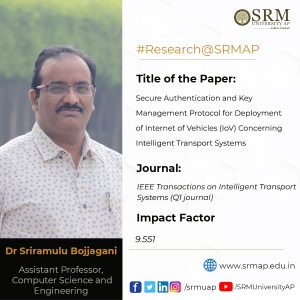 Intelligent transport systems embedded with latest technology is the future of automotive industry and can revolutionise the very infrastructure and architecture of transportation. The principles of intelligent transportation systems have manifested in the development of Internet of vehicles (IoV), a novel technological network that enables autonomous and connected mobile commutation facility. Dr Sriramulu Bojjagani, Assistant Professor, Department of Computer Science and Engineering, has published a paper on this seminal topic titled “Secure Authentication and Key Management Protocol for Deployment of Internet of Vehicles (IoV) Concerning Intelligent Transport Systems” in the prestigious journal, IEEE Transactions on Intelligent Transport Systems (Q1 journal) having an Impact factor of 9.551. The paper highlights the development and significance of the pioneering AKAP-IoV system in successfully tackling cyber threats and security vulnerabilities.
Intelligent transport systems embedded with latest technology is the future of automotive industry and can revolutionise the very infrastructure and architecture of transportation. The principles of intelligent transportation systems have manifested in the development of Internet of vehicles (IoV), a novel technological network that enables autonomous and connected mobile commutation facility. Dr Sriramulu Bojjagani, Assistant Professor, Department of Computer Science and Engineering, has published a paper on this seminal topic titled “Secure Authentication and Key Management Protocol for Deployment of Internet of Vehicles (IoV) Concerning Intelligent Transport Systems” in the prestigious journal, IEEE Transactions on Intelligent Transport Systems (Q1 journal) having an Impact factor of 9.551. The paper highlights the development and significance of the pioneering AKAP-IoV system in successfully tackling cyber threats and security vulnerabilities.Abstract
Intelligent transport systems amalgamated with advanced technologies are an important element of the automotive industry, including critical infrastructure and transportation. Internet of Vehicles (IoV) is the modern technological framework designed for intelligent transportation. IoV creates a network of information relations among vehicles, thus contributing to reduced congestion, roadside infrastructure, driver/traveller safety, and traffic efficiency through wireless communication and sensing technology. However, a significant challenge in IoV applications is security, as criminals could potentially exploit these applications. Despite increasing industry awareness, the potential danger posed by security vulnerabilities and cyber threats remains high. In this study, we have designed a new system called AKAP-IoV, which supports secure communication, mutual authentication, and key management among vehicles, roadside units, and fog and cloud servers. AKAP-IoV was tested and verified using Scyther and Tamarin to ensure its resistance to cyber threats. Furthermore, we conducted a formal security analysis using the Real-or-Random (RoR) oracle model to assess security properties logically. In addition, a detailed, comprehensive comparative study was considered to evaluate the performance, functionality, efficiency, and security features supported by AKAP-IoV compared to those of recently developed schemes.
Continue reading → - Study on C and N dynamics in response to climate change October 25, 2022
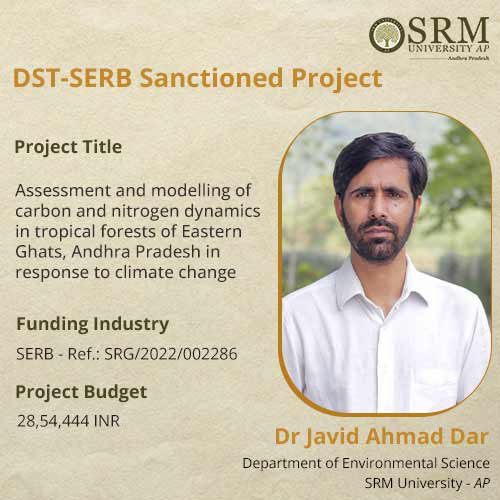 Tropical forests are the breathing lungs of the world that work as a collective to stabilise climate by absorbing vast amounts of carbon dioxide. Covering over 12% of Earth’s total land surface. It functions as a harbour for evolution and supplying prerequisite rainfall for healthy vegetation. Recent global climate changes have catalysed drastic effects on the tropical forests and the healthy functioning of the same. A critical understanding of the present state of forest ecosystems is crucial for undertaking necessary measures to prevent further degradation.
Tropical forests are the breathing lungs of the world that work as a collective to stabilise climate by absorbing vast amounts of carbon dioxide. Covering over 12% of Earth’s total land surface. It functions as a harbour for evolution and supplying prerequisite rainfall for healthy vegetation. Recent global climate changes have catalysed drastic effects on the tropical forests and the healthy functioning of the same. A critical understanding of the present state of forest ecosystems is crucial for undertaking necessary measures to prevent further degradation.Recently, the project entitled Assessment and modelling of carbon and nitrogen dynamics in tropical forests of Eastern Ghats, Andhra Pradesh in response to climate change, has been sanctioned to Dr Javid Ahmad D, Assistant Professor, Department of Environmental Science by DST – SERB (Science and Engineering Research Board), Govt of India, with a total outlay of Rs. 28.54 lakhs. Dr Javid Ahmad D is the principal investigator of the project.
A complete dataset on long-term dynamics in vegetation, the C and N generated for different tropical forest types in the Eastern Ghats landscape would serve as a baseline data for forest managers and policy-makers. The project aims to gain insight on the response of these tropical forests to changing global climate in relation to multiple factors (elevated CO2, increased temperatures and altered precipitation).
Continue reading → - Tunnel Field Effect Transistor Design and Analysis for Biosensing Applications October 11, 2022

The Department of Electronics and Communication Engineering is glad to announce that Mr Garikapati Anith Chowdary, a BTech passed-out student has published a paper in collaboration with Assistant Professor Dr M Durga Prakash. The paper titled Tunnel Field Effect Transistor Design and Analysis for Biosensing Applications was published in the Q2 journal Silicon having an Impact Factor 2.941.
The physical modelling of the tunnel field effect transistor (TFET) is done in this study. The Silvaco TCAD tool is used to design and simulate the TFET structure. The FET device has attracted a lot of attention as the ideal tool for creating biosensors because of its appealing properties such as ultra-sensitivity, selectivity, low cost, and real-time detection capabilities in a sensing point of view.
These devices have a lot of potential as a platform for detecting biomolecules. Short channel effects, specificity, and nano-cavity filling have all been improved in FET-based biosensors. FET-based biosensors are appropriate for label-free applications. Random dopant variations and a thermal budget are seen during the construction of a JLFET. To overcome this problem, the charge-plasma-based concept was established in FETs in this study.
Different metallurgical functions for electrodes were employed in this biosensor to behave as a p-type source and n-type drain. To alleviate the short channel effects, a dual material gate work function for the gate electrode was devised, as well as a double gate architecture. Biomolecules can be neutral or charge-based, and both types of biomolecules can be identified using a proof-of-concept FET-based biosensor. Changes in the drain current (Id) of the device were achieved by varying dielectric values and charges in the cavity region with variable cavity lengths.
Continue reading → - In-situ Al–5ZrB2 composite foams : Comparable alternative for conventional Al foams October 7, 2022
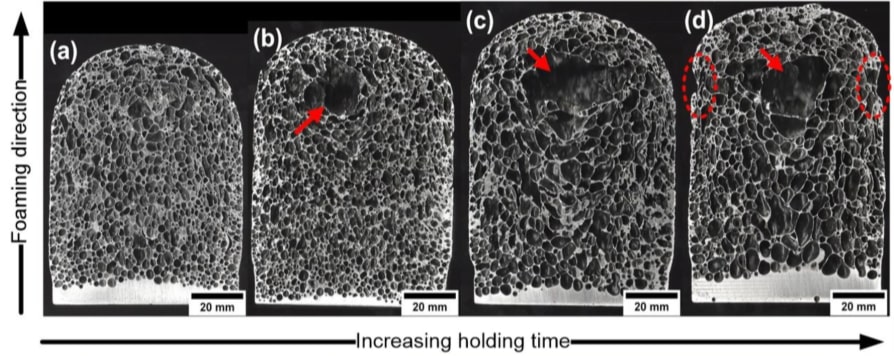
Closed-cell metal foams are crucial to heavy industry machinery as they primarily function as impact-absorbing materials. Stabilizing closed-cell metal foams is a pivotal element in the process of manufacturing closed-cell metal foams. On this note, Prof GS Vinod Kumar from The Department of Mechanical Engineering has published a paper entitled Production, stability, and properties of in-situ Al–5ZrB2 composite foams in the journal Materials Science and Engineering: A with an impact factor of 6.044.
Abstract
Stabilization is an essential requirement to produce closed-cell metal foams. In the melt route of foaming, usually ceramic particles are used as foam stabilizers. For the first time, the present study introduces ZrB2 particles as foam stabilizers. We demonstrate the foaming of in-situ based Al composite containing submicron ZrB2 particles. The effect of foaming temperature and holding time on the structural and mechanical properties of the foams was studied. The composites and foams were characterized using XRD, SEM/EDS, and optical scanning techniques. The mechanical properties of the foams were determined by subjecting the foams to a quasi-static compression test. Submicron ZrB2 particles present in the cell wall and at the gas-solid interface promoted foam stability. All the foams exhibited a good cellular structure with high expansion. Among the foams, the foams prepared at 680 ºC with a holding time of 120 s exhibited the smallest cell size and the best mechanical properties. The structural and mechanical properties of the Al–5ZrB2 foams were found to be comparable to conventional foams.
Novel in-situ ZrB2 particles were produced to form Al-5ZrB2 composites. ZrB2 particles present in the melt tend to stabilize the H2 gas bubbles produced from the decomposition of TiH2. The macrostructure was best observed when foamed at 680 ºC and held for 120 sec. Because of its finer pores ( ̴ 3mm ), excellent compressive strength and energy absorption capacity was exhibited comparable to conventional Al foams.
The paper observes a wide-range of possibilities for the application of in-situ Al–5ZrB2 composite foams to modify bullet proof vests, car body parts, sound and heat proof walls in theatres, naval ship bodies, etc.
Prof Vinod Kumar also discusses the future application of this technique in use of metallic powders as blending agent for effective dispersion of blowing agent in the melt and in the field of compressive and energy absorption studies for Al composite foams.
Continue reading → - Two paper publications from Prof G S Vinod Kumar and his scholar September 29, 2022
A robust body of published works helps advance research capabilities and contribute to the larger research domain. Two latest paper publications from the Department of Mechanical Engineering are co-authored by Prof G S Vinod Kumar and his PhD student, Mr Akshay Devikar.
 The first paper, Stabilization and Mechanical Properties of Mg-3Ca and Mg-3Ca/SiC/5p foams alloyed with Beryllium, got published in the Journal of Materials Engineering and Performance and had an impact factor of 2.036.
The first paper, Stabilization and Mechanical Properties of Mg-3Ca and Mg-3Ca/SiC/5p foams alloyed with Beryllium, got published in the Journal of Materials Engineering and Performance and had an impact factor of 2.036.Liquid processing of Magnesium is complicated due to its uncontrolled flammability in the presence of oxygen. However, owing to the lightweight property of Mg, it can be used as a structural material in various sectors such as naval, aerospace, automobile, biomedical, heat exchangers, and military applications. Therefore, using Ca and Be as alloying elements and oxidation preventers, the researchers produced lightweight Mg foams (of density 0.17 g/cm 3), which float on water. SiC particles provide excellent Mg foam stabilisation as well. The compression tests revealed the highest strength for Mg-3Ca foam containing both Be and SiC. Thus, the burning problem of Mg was overcome by adding Ca and a trace quantity of Be to make lightweight foams, which were strengthened by SiC particles.
Abstract
The present paper investigates the stabilisation of Mg-3Ca alloy and Mg-3Ca/SiC/5p composite foams with and without the addition of 0.12 wt.% beryllium. In Mg-3Ca alloy foam, Be addition has significantly improved the expansion and pore structure. Whereas, in the case of Mg-3Ca/SiC/5p composite foams, the SiC particles stabilised the foam effectively, while Be addition did not show any distinguishable improvement in the foam structure. The formation of BeO and the dense coverage of SiC particles in the gas-solid interface of Mg-3Ca and Mg-3Ca/SiC/5p composite foams, respectively, are the reasons for the foam stabilization. Mg-3Ca/SiC/5p composite foam exhibited the lowest foam density of 0.10 g/cm3. The quasi-static compression test shows that Mg-3Ca-0.12Be/SiC/5p composite foam containing Be exhibited lower foam density and higher normalized compressive strength. The energy absorption capacity per unit foam density in Be containing foams was also higher.
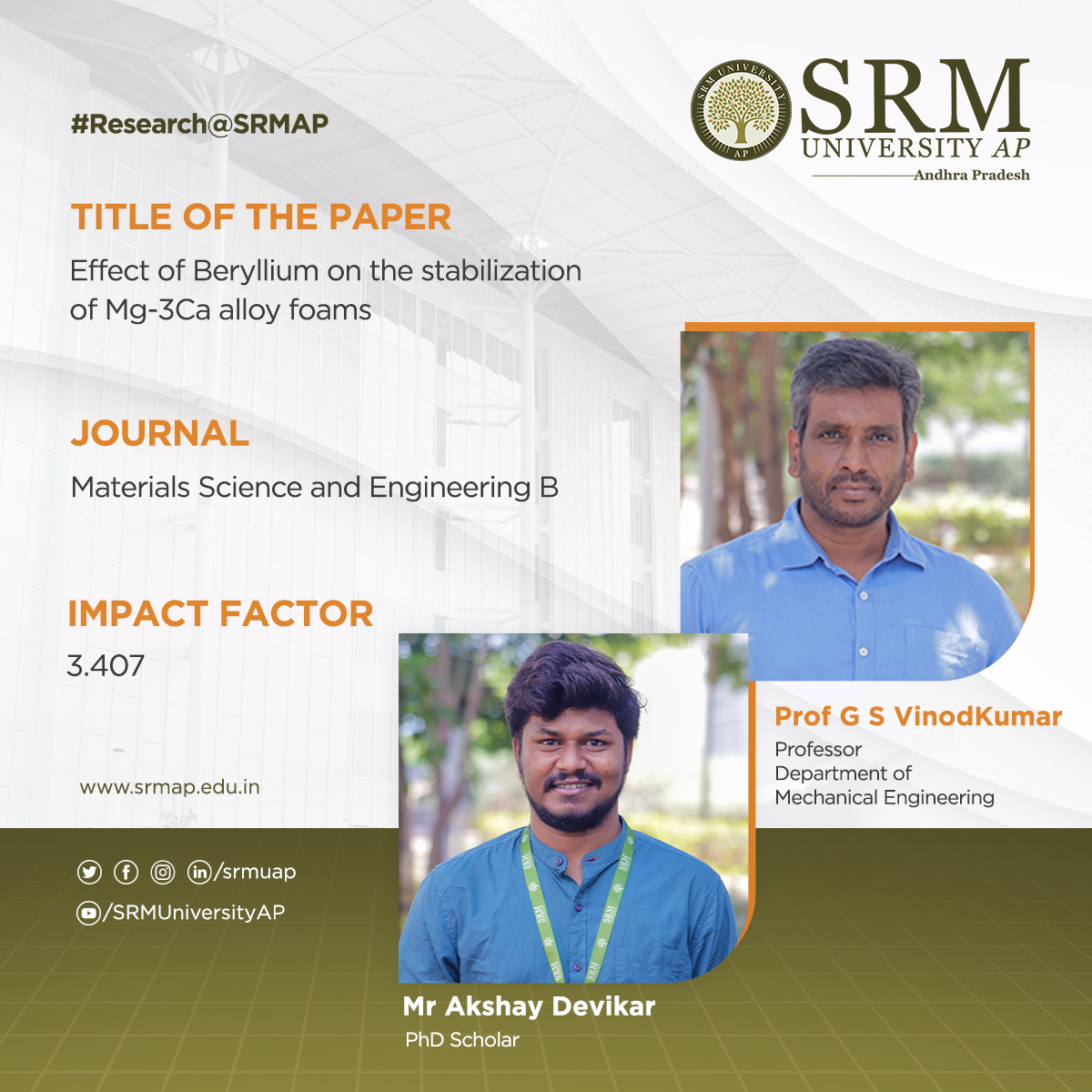 The second paper, the Effect of Beryllium on the stabilization of Mg-3Ca alloy foams, is published in the journal Materials Science and Engineering B with an impact factor of 3.407.
The second paper, the Effect of Beryllium on the stabilization of Mg-3Ca alloy foams, is published in the journal Materials Science and Engineering B with an impact factor of 3.407.Mg-3Ca alloy foams of density as low as 0.25 g/cm3 were successfully produced via the liquid metal route in an open-air atmosphere with trace Be addition. The stable BeO layer formed at the gas-solid interfaces of pores restricted the Mg + CO2/CO reaction, thereby reducing the gas loss responsible for foaming. Be addition (0.13 wt.%) resulted in a high-volume expansion of Mg-3Ca foam (694 %). Metallic single films also exhibited smooth and crack-free interfaces with Be addition.
Abstract
The present work is the first-ever study where the influence of beryllium (Be) addition on the stability of Mg alloy foam was investigated. Mg-3Ca alloy foams were produced by the liquid processing route with and without Be micro-addition. CaCO3 was used as a blowing agent. Mg-3Ca alloy foam without Be resulted in stable foam but exhibited low expansion with poor foam structure. Be addition significantly increased foam expansion and improved their structure. The expansion and the structure of the Mg foams obtained are comparable with that of commercially available aluminum foams. The XPS analysis confirmed the presence of BeO at the gas-solid interface of Mg foam. Be stabilizes the gas-solid interface of the foam by forming a smooth and crack-free surface of the BeO layer, which prevents the continuous oxidation of liquid foam and minimises the loss of blowing gas, thereby enhancing the stability of Mg-3Ca alloy foams.
Bulletproof vests, Car body parts, Hip and Knee implants, Sound and heat-proof walls in theatres, Naval ship bodies, etc., are some of the applications of the research findings. The researchers have collaborated with Dr Manas Mukherjee (Associate Professor) and his PhD student, Mr Biswaranjan Muduli of the Department of Metallurgical and Materials Engineering, Indian Institute of Technology Madras, Chennai, for this work. Stabilisation using other alloying elements and ceramic particles for improving mechanical properties of Mg foams specific to application requirements and establishing structure-property relationship from the point of view of melt viscosity by altering the foaming parameters are the future plans of the research team.
Continue reading → - SRM University- AP observes Research Day 5th Edition September 29, 2022
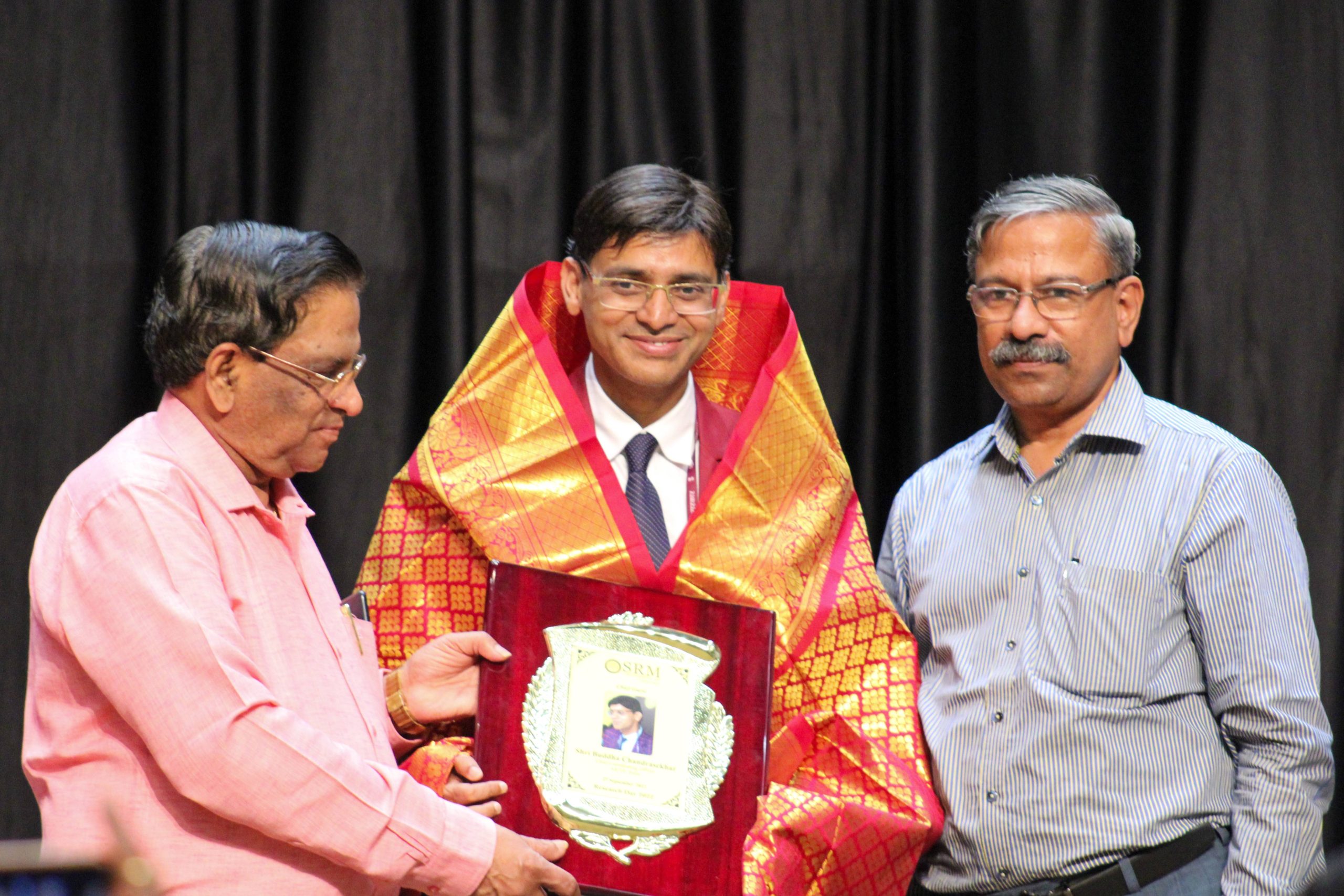 Research Day celebration at SRM University-AP continues to uplift the momentum of various research endeavors at the university and actuate the agenda of a research-oriented educational institution. The illustrious event held on Tuesday, September 27, 2022, fosters the exchange of information across disciplines, encourages extensive research projects, and appreciates innovative efforts in research. Dr Buddha Chandrasekhar, Chief Guest of the event, lauded the fundamental ideology of the initiative and highlighted the need to develop Indian students as world-class skilled workforce and entrepreneurs by providing real-time internship opportunities where industry and academy stay connected.
Research Day celebration at SRM University-AP continues to uplift the momentum of various research endeavors at the university and actuate the agenda of a research-oriented educational institution. The illustrious event held on Tuesday, September 27, 2022, fosters the exchange of information across disciplines, encourages extensive research projects, and appreciates innovative efforts in research. Dr Buddha Chandrasekhar, Chief Guest of the event, lauded the fundamental ideology of the initiative and highlighted the need to develop Indian students as world-class skilled workforce and entrepreneurs by providing real-time internship opportunities where industry and academy stay connected.Prof D Narayana Rao, Pro Vice-Chancellor, SRM AP, welcomed Dr Buddha Chandrasekhar, Chief Coordinating Officer, All India Council for Technical Education (AICTE), and other esteemed dignitaries. “Research and innovations are integral to growing and sustaining a large and vibrant society and economy. Innovations in science and technology are an integral part of the long-term growth and dynamism of any nation,” he stated and proceeded to elaborate how universities are proven as creators of new knowledge, innovative ideas, providers of skilled manpower, agents of social change, and symbols of international attention and research.
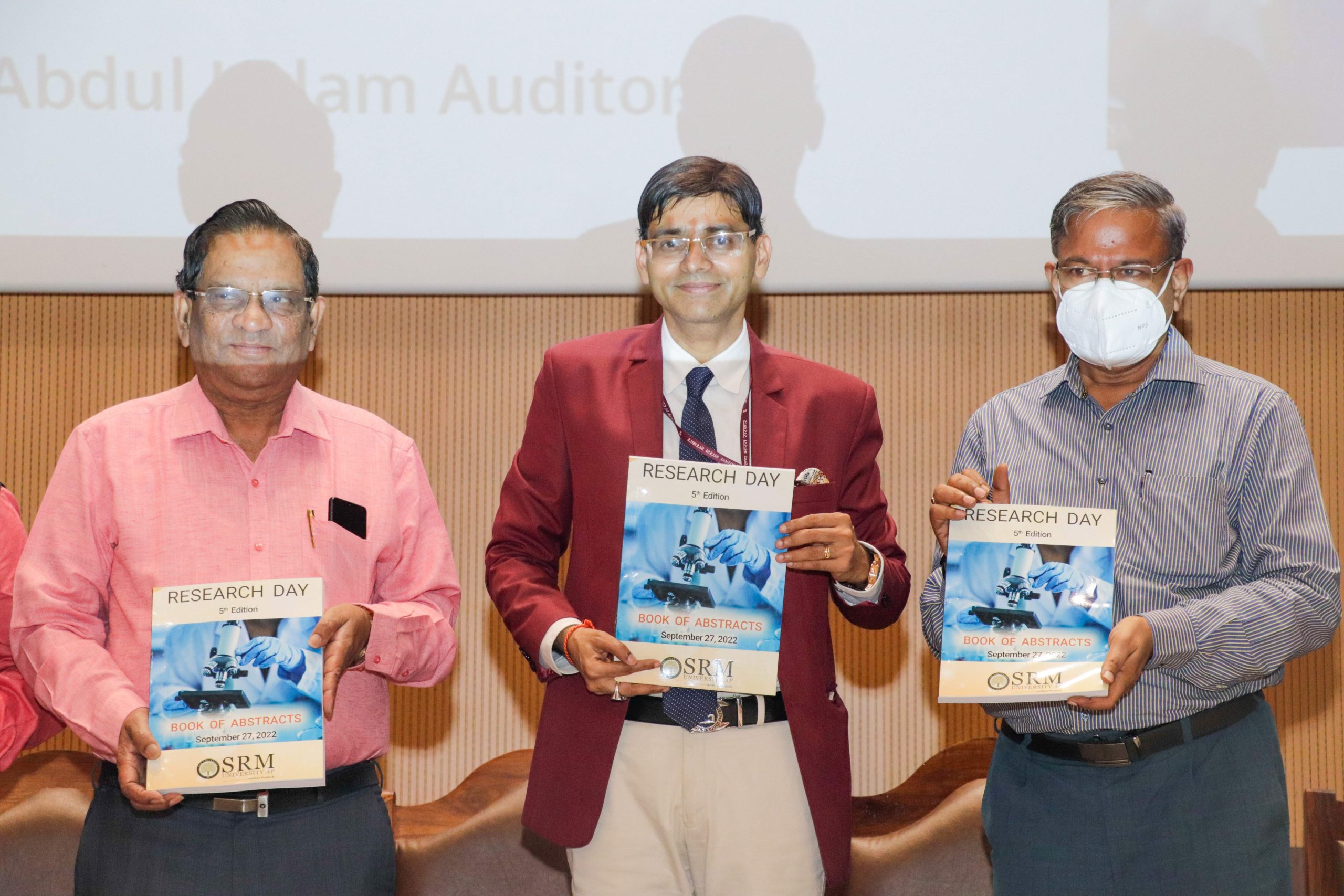 Dr Buddha Chandrasekhar shared his concerns regarding the widening gap between academy and industry and expressed his determination to reduce at least 5% unemployment in the country. He also demonstrated the websites 1crore aicte and aicte internship developed under the Ministry of Education and explained the arena of possibilities it opens to the youth of India.
Dr Buddha Chandrasekhar shared his concerns regarding the widening gap between academy and industry and expressed his determination to reduce at least 5% unemployment in the country. He also demonstrated the websites 1crore aicte and aicte internship developed under the Ministry of Education and explained the arena of possibilities it opens to the youth of India.As part of Research Day, students and faculty were advised to submit their research abstracts. A special issue of the research abstracts booklet comprised of all the selected abstracts was unveiled during the event. Gold medals and certificates have been awarded to qualified students and their mentors for their research work in various thematic areas. Dr Buddha Chandrasekhar displayed his enthusiasm to know further details of their research works and urged all the awardees to meet him in person after the event for a brief interaction.
Continue reading → - Applications of federated learning in computing technologies September 26, 2022
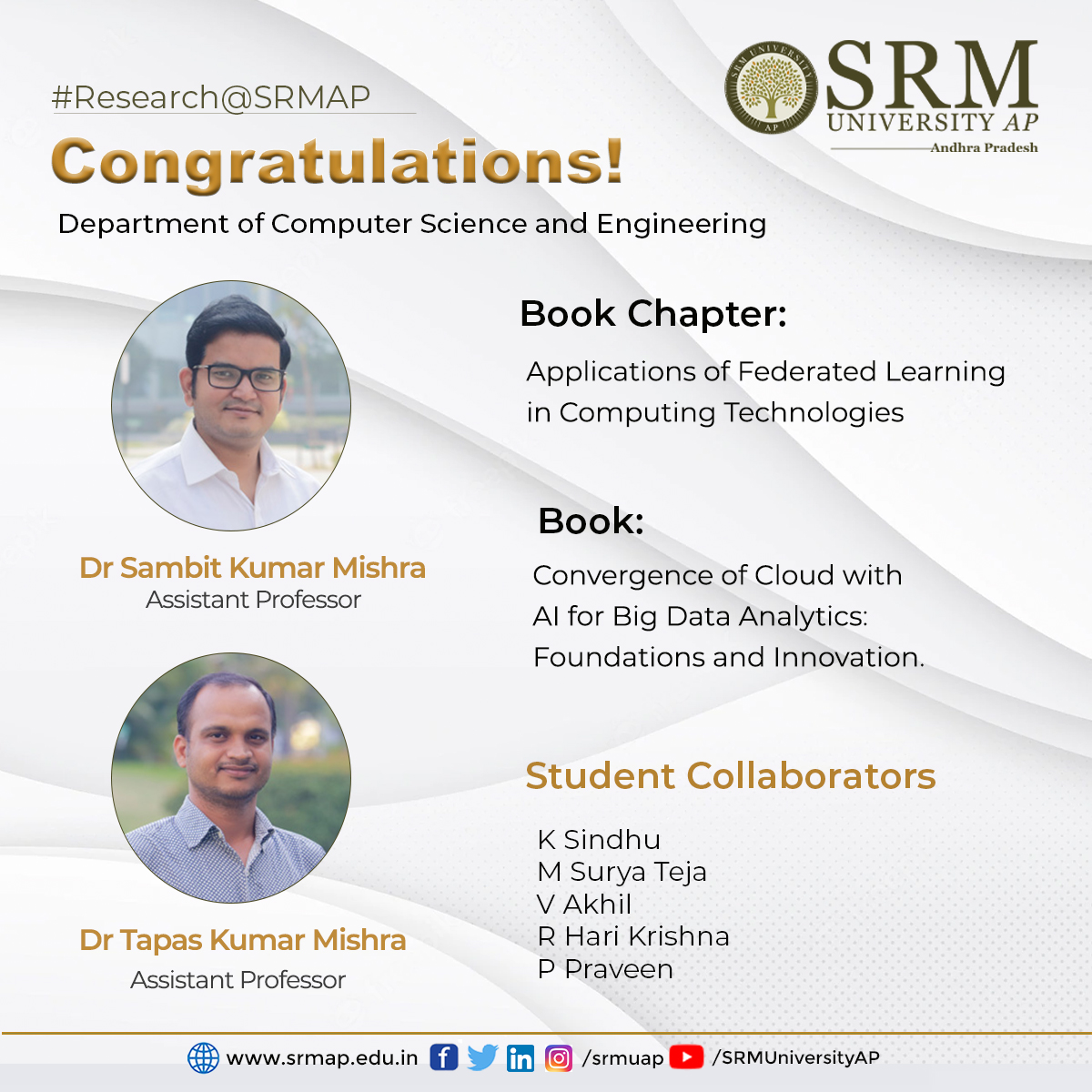
The Department of Computer Science and Engineering is delighted to announce that Assistant Professors, Dr Sambit Kumar Mishra and Dr Tapas Kumar Mishra, and the final year BTech students – Kotipalli Sindhu, Mogaparthi Surya Teja, Vutukuri Akhil, Ravella Hari Krishna, and Pakalapati Praveen – published a chapter titled Applications of Federated Learning in Computing Technologies in the scopus-indexed book titled Convergence of Cloud with AI for Big Data Analytics: Foundations and Innovation, a Wiley publication.
The book chapter describes the application of federated learning to various computing technologies. The federated learning concept is similar to the client-server model, where the client sends data to the server for processing and the processed data is again sent to the client. But, in federated learning, the clients are allowed separately to teach the deep neural network models with the local data combined with the deep neural network model at the central server.
Federated learning is a machine learning technique that trains the knowledge across different decentralized devices holding samples of information without exchanging them. The concept is additionally called collaborative learning. Researchers have used large frameworks for all the computations in the past years, and then they have moved to client-server frameworks.
It is also like a traditional centralised machine learning technique. All the local datasets are uploaded to a minimum of one server, so it assumes that local data samples are identically distributed. Because of its security and privacy concerns, it’s widely utilised in many applications like IoT, cloud computing; Edge computing, Vehicular edge computing, and many more. In the chapter, different applications of federated learning, their privacy concerns, and their definition in various fields of computing technologies like IoT, Edge Computing, Cloud Computing, Vehicular edge computing, etc. are presented. It will be of advantage to graduate students, researchers, academicians, institutions, and professionals that are interested in exploring the areas of intelligent computing systems.
- Industry project sanctioned to Prof G S Vinod Kumar September 23, 2022
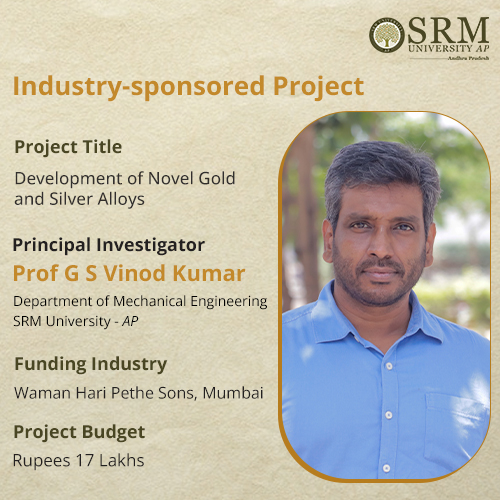
The research project titled Development of Novel Gold and Silver Alloys was sanctioned to Prof G S Vinod Kumar from the Department of Mechanical Engineering. The project was sanctioned by Waman Hari Pethe Sons, a leading Gold/Diamond jewellery manufacturing company based in Maharashtra, with a total outlay of Rupees 17 Lakhs. The tenure of the project is two years, from May 2022 to May 2024.
Prof Vinod Kumar’s research interests mainly revolve around the hardening of 22 carats and 24 carats gold for light-weight and high-strength jewellery and the novel processing of light alloy (Al and Mg) foam and studying the structure and properties. He has been intensely involved in the development of technologies for improving the hardness of 22k gold for weight saving and high strength in the cast and hand-made jewellery. This was jointly patented by SRM and Titan. He also has several industrial research partnerships and funded projects to his credit.
The present project aims to develop novel high carat gold (24,22 and 18 carats) for high-strength and light-weight jewellery applications and novel silver alloys (high pure (99%) or sterling silver (92.5%)) having better anti-tarnishing capability. It further aims to develop colour gold alloys (Black, violet and pink gold). The project also involves both the lab-scale and industrial development of the process for scaling up jewellery production of the gold and silver alloys.

